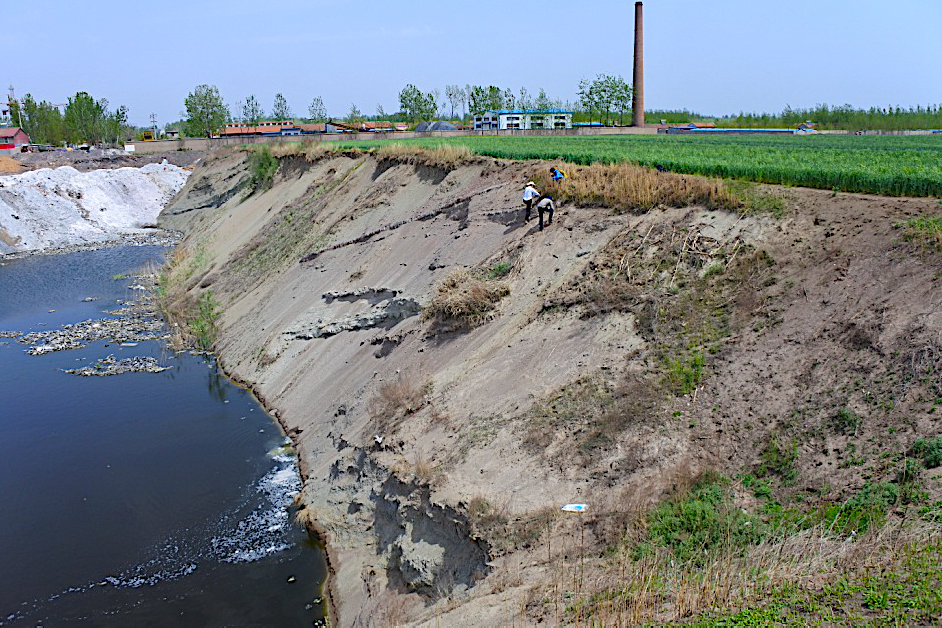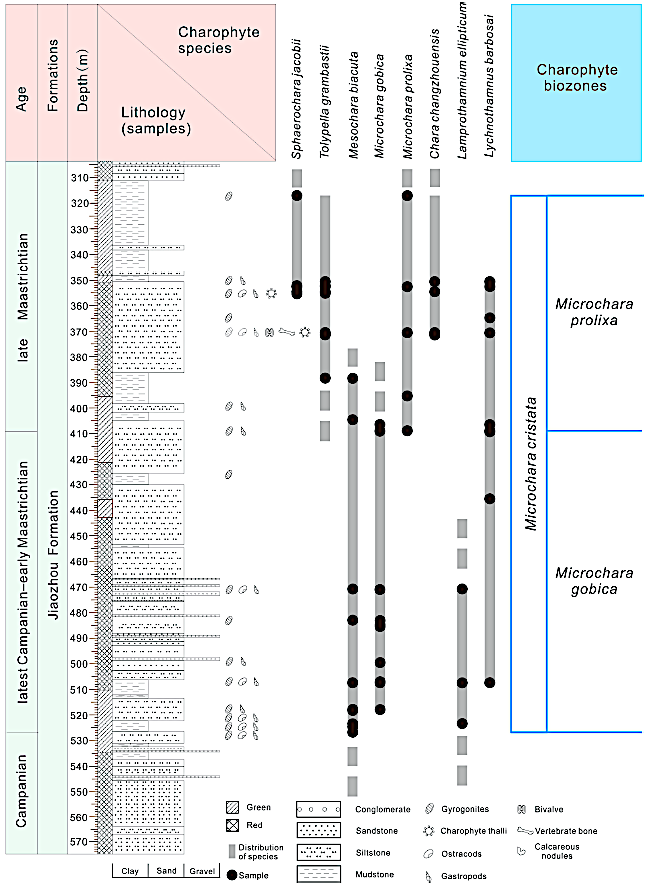Jiaozhou Fm
Type Locality and Naming
Jiaolai Basin. The Shandong Regional Geological Survey erected the Jiaozhou Formation in 1991. The locality for the designation is in Jiaozhou City of Shandong Province. The type section was measured by Liu Mingwei et al (1992) at the Gujiamiao-DongxinZhi section of Jiaoshou City (119º59', 36º19'). Highest formation in the Wangshi Gr.
Lithology and Thickness
The Jiaozhou Formation is composed of purple fine-grain sandstone, siltstone, grayish green mudstone, marl, and yellowish brown siltstone, gravel-bearing sandstone. A scientific drilling of the LK-1 reveals 1600 m strata with the Hongtuya, Shijiatun, and Jiaozhou formations cored in ascending order. The borehole is located in the north of Jiaozhou City, Shandong Province. The Jiaozhou Formation is 614.5 m thick in the LK-1 borehole. It is mainly composed of green and red sandstones, siltstones and claystones, interbedded with conglomerates, with cross-bedding, parallel bedding and horizontal bedding, containing calcareous concretions and gypsum. Generally, the thickness of Jiaozhou Formation ranges from 600 m to 1172 m.
[Figure: Jiaozhou Formation in Jiankou Village of Weifang City, Shandong]
Relationships and Distribution
Lower contact
It has a conformably contact with the underlying Hongtuya Fm.
Upper contact
Regional extent
This formation occurs in the Jiaozhou City and Taigongtang, Zhangling of the Changyi City. Lithologically, it is of more purple siltstone and mudstone with intercalations of grayish green siltstone and sandstone in Jiaozhou. In the Changyi City, it is dominated by grayish red siltstone intercalated with grayish green yellowish muddy siltstone, silty mudstone and whitish conglomerate.
GeoJSON
Fossils
The formation bears ostracod Eucypris-Cyprois Assemblage, sporopollen Ulmipollenites-Ulmoideipites-Aquilapollenis Assemblage.
Li Sha et al. (2021) studied the Cretaceous- Paleogene boundary at the Jiaozhou Formation in the LK-1 borehole, and proposed that the Cretaceous/Paleogene boundary is possibly in the upper part of the Jiaozhou Formation. The Jiaozhou Formation in the LK-1 borehole yields numerous fossils including gastropods, ostracods, and charophytes, of which charophytes can provide biostratigraphic age constraints. From the core, 31 samples from this formation yielded identifiable charophytes (Fig). Eight species belonging to 6 genera were identified including S. jacobii, Meso. biacuta, Micro. gobica, Micro. prolixa, Microchara sp., Ch. changzhouensis, Lam. ellipticum, and Tolypella grambasti. The charophyte biostratigraphy of the Jiaolai Formation could be correlated to that of the Sifangtai Fm and Mingshui Fm in the Songliao Basin, which was calibrated to the GPTS (Deng et al., 2013). The flora at depths from 527 to 471 m is dominated by Micro. gobica, Lam. ellipticum and Meso. biacuta, being similar to the latest Campanian flora in the Songliao Basin. The deposits at depths from 471 to 410 m contain very rare fossils, with only one gyrogonite found. They are considered to be correlated to the early Maastrichtian almost barren strata in the Songliao Basin, and therefore are inferred to be early Maastrichtian in age. Appearance of Micro. prolixa at the depth of 409 m was inferred to be late Maastrichtian in age. Appearance of Ch. changzhouensis at the depth of 371.50 m indicates that this layer is very close to the K–Pg boundary because the species was found from the uppermost Cretaceous to the lowermost Paleocene in the Songliao Basin where the strata were calibrated to the GPTS (Deng et al., 2013; Li et al., 2018a). Furthermore, S. jacobii at the depth of 355.30 m is even closer to the boundary with its first appearance at the base of the C29r zone in the Songliao Basin (Deng et al., 2013; Li et al., 2021).
[Figure: K-Pg boundary and charophyte zones of Jiaozhou Formation in LK-1 borehole in Jiaozhou City (revised from Li et al., 2021)]
Age
Depositional setting
This formation was deposited in alluvial fan, braided river, meandering river, fan delta, and shallow lake deposits.
Additional Information

